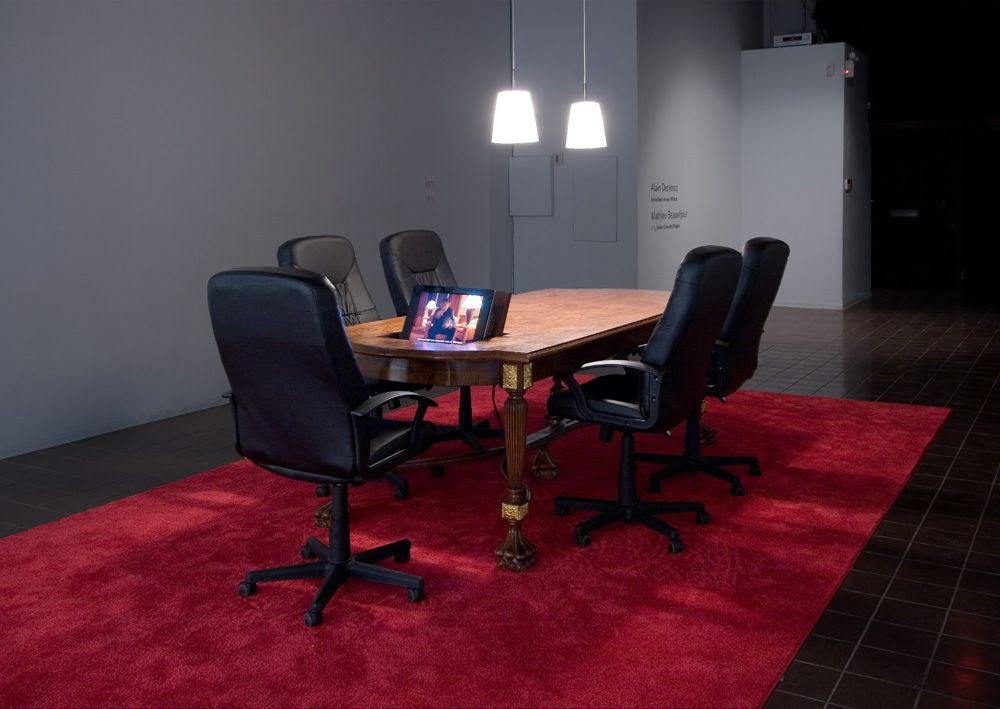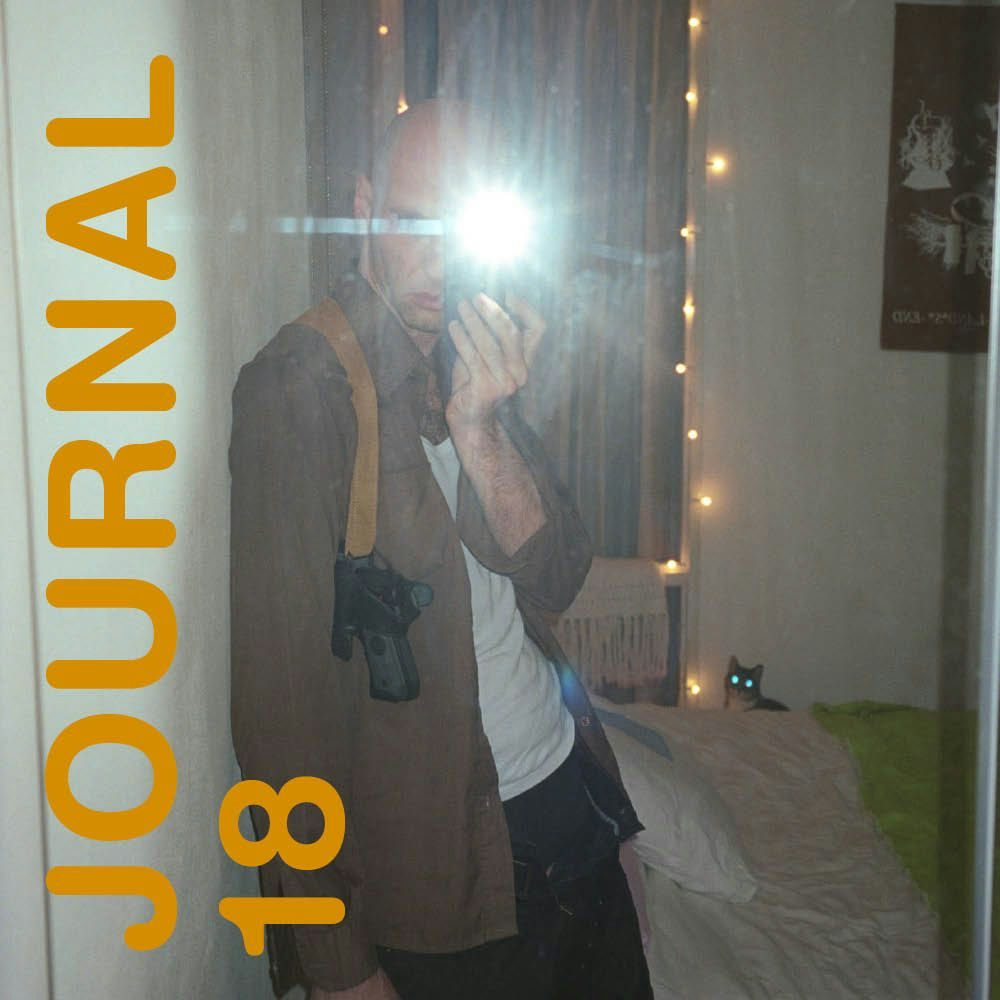
Alain Declercq
Embedded Versus Wildcat
2006.09.09 - 10.21
NINA FOLKERSMA
Saturday, March 26, 2005, 3:30 p.m.
A fair on the Dam, Amsterdam
Alain Declercq is in town for an event devoted to conspiracy theories. He screens a short film and talks about the new project he’s currently working on, Mike, which will follow the odyssey of a secret agent seeking answers to questions raised by the events of September 11, 2001. […]

Friday, June 24, 2005, between 11 a.m. and 4 p.m.
Alain Declercq’s apartment, Rue Brulatour, Bordeaux
While Declercq is busy putting the finishing touches on his film in a nearby studio, the Bordeaux apartment he’s sharing with a journalist friend, C.P., is the scene of an unannounced visit by a delegation from the French Crime and Anti-Terrorism bureau. The fifteen-man squad searches the apartment, turning up a fair amount of suspect materials: a text on Al-Qaeda, replica weapons, airline tickets, photocopied 500-Euro notes, a Polaroid picture of a missile hitting the Pentagon… Certain they have stumbled upon a secret Al-Qaeda cell in France, which surely has links to the Madrid network, they immediately bring charges against Declercq. Several times during their investigation, a name crops up: “Mike.” It takes five hours of interrogation for the authorities to begin to wonder who this Mike is, and finally query Declercq on the nature of his relationship with the enigmatic figure, who isn’t mentioned anywhere in their records. Declercq tries to explain: the entire thing is a work of art, a fiction. He is neither a criminal nor a terrorist—indeed, he works in a field where one aspires to openly engage as wide an audience as possible! Declercq takes up the narrative: “The problem was, at one point, they started wondering whether ‘artist’ wasn’t precisely the perfect alias, the most brilliant cover for terrorist activities. At that point, obviously, if you want to be persuasive, you’d better hold tight.” When I ask whether the file has been closed since then, his answer is noncommital. His house, he says, is still under surveillance; his phone line tapped. Packages he mails rarely get to their destinations. “I only saw the tip of the iceberg: fifteen cops, a five-hour interrogation, a judge. I don’t know what it’s all hiding, or what might come next.”
Later the same day, between 3:00 and 4:10 p.m.
C.P.’s apartment, 77 rue Lamarck, Paris
Scant hours after the police raid in Bordeaux, C.P., Declerq’s journalist friend, gets a call informing him that his Paris apartment has been burgled. The break-in took place sometime between 3:00 and 4:10 p.m. A notebook computer and digital camera are gone, yet a DVD player and cheque-book that were lying in plain view remain. An official inquiry ensues, and concludes there was no evidence of any link between the two events.
Elementary conspiracy theory, however, teaches us that there is no such thing as a coincidence. In this way of apprehending the world, everything is connected. There are no simple facts and no fortuitous consequences; “it all means something.” That no doubt explains why the logic of conspiracy theorizing has met with such popular success, as seen in Dan Brown’s Da Vinci Code, Michael Moore’s Fahrenheit 9/11, or the final film by Theo van Gogh, 06/05, about the murder of Pim Fortuyn. Conspiracy theories do paint a fairly accurate picture of reality. Invisible outlaw terrorist networks. Shady operations. Hidden information. And the question is always the same: Who profits from it all? The rich and powerful, the multinationals, the elites! cry the theorists. Surely we can prove that there’s an Evil-Genius Bad Guy lurking behind every detail, every anecdote and the slightest morsel of information lying around… Conspiracy theories are reassuring: in a world that’s becoming more and more complex and difficult to understand, they offers a simple, coherent—and therefore vastly appealing—paradigm for apprehending the world.
Thursday, September 15, 2005, 6:00 p.m.
40 rue de Seine / 2, rue de l’Échaudé, Galerie Loevenbruck, Paris
A fairly standard desk stands in the middle of the room. […] Across from it, a staircase leads to the cellar. There, in a small room, unspools Mike, the most recent, highly anticipated film by Alain Declercq, at a sneak-preview screening.
The work is made up of shots seemingly captured clandestinely, edited together like a reel of rushes. The first segment takes place Somewhere in the Middle East. A group of men are on their knees right in the middle of a street; the muezzin’s wail ululates across the rooftops; a Jeep slices through desert sands, past a soldiers’ encampment. Next we’re in Washington: sombre-suited men shuttle between luxury hotels doing their business; diplomatic vehicles glide in circles in front of the Pentagon. The film is brimming with recognizable signifiers, whose charge and suggestive power assert themselves, little by little. The last segment takes us to Europe: the fair in Amsterdam; a Paris office complex; a U.S. military base in the south of England. All the images are filmed by the same individual: Mike, who styles himself an intelligence agent. Occasionally, he appears on screen, to recount what he has seen and heard on a given day. But virtually everything Mike is able to observe seems to lead down a blind alley. Suddenly, plenty of things are left without explanation. At the same time, Declercq tells me, his film contains an abundance of coded information. Nearly every shot, every name and every codename is inspired by a theory or actual fact. The film is a mélange of demonstrations and speculations that breeds confusion. Is Mike a secret agent? Is he a terrorist? Which part of the narrative is reality, and which part fiction? What is certain is that Alain Declercq, with this film, shows how easy it is to fan the flames of fear and mistrust in this day and age. And what is even more certain is that the filmmaker in this instance was able to appreciate, at the risk of his life, the consequences of his little excursion onto politically shifting sands. And must not be forgotten is that the artist in this instance produced a work of fiction. He did not allow himself to be drawn into the current vogue of paranoia, or to the idée fixe that shadowy forces are controlling our lives. His judgement is sound: he is capable of having doubts about his own doubts. And his imagination enables him to relate, based on proven facts, a parallel story—in the process suggesting reality an alternative. And, in so doing, demonstrating the critical and creative possibilities that conspiracy theorizing offers.
Excerpted from an article published in Metropolis M, No. 6, 2005.